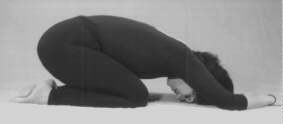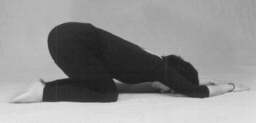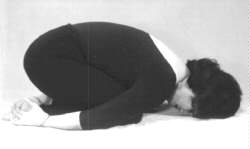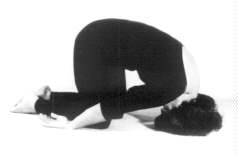|
Shashankasana - The Pose of the Moon
|
by: Vasanthi Bhat and Rajiv Jaswa (vasanthi@vasanthayoga.com)
Shashankasana(shuh-shank-ahs-ah-na), or the pose of the moon,
and its many variations are some of the many yogic poses that
can be harnessed by anyone to achieve various mental and physical
benefits. The poses discussed in this article
are some of the easiest poses to practice physically, and therefore
can be done by virtually anyone. In this article, some of the
benefits and meditations that are related with this pose will
be discussed.Mental Benefits of Shashankasana
In Shashankasana, the head is bent downwards, allowing better
circulation towards the brain. This has numerous benefits, such
as improved concentration and memory. It is also a rejuvenating,
refreshing, and relaxing pose. This is perhaps the most useful
mental benefit, as everyone suffers from stress and mental exhaustion
at some point, and this will help you combat it.
Meditating in Shashankasana
Shashankasana is a very good pose to meditate in as it is relaxing
and comfortable to remain in for long periods of time. Meditation
is a way to take a step back from life, and look at your problems
in a more relaxed state. It is easier to think clearly and find
a deeper meaning in things when we are meditating. When you are
doing this either concentrate on your breath, flowing in and out
of your body, or concentrate on whatever good you can find in
your day or life. This achieves a positive state of mind that
will help you after you have come out of you meditation. Also,
when you are one with your breath, will feel calm and peaceful
like the gentle flow of your inhalation and exhalation. If you
find any disturbing thoughts, do not block them out, because they
will only continue to disturb you. Instead try and find a solution
and iron out all of the wrinkles. Another way that you can meditate
in Shashankasana is by concentrating on the physical benefits
that you wish to achieve through doing this pose. This will help
magnify these benefits which will be discussed in the following
paragraph.
Physical Benefits of Shashankasana
There are numerous physical benefits that are a result of practicing
Shashankasana. Some require daily practice, while others are
instantaneous benefits. For example, headaches and sinus congestion
almost immediately go away after one stays in this pose for a
few minutes. Consistent practice of this pose has other benefits.
The increased circulation that comes when you practice this pose
helps the heart. But, most of the physical benefits are related
to the spinal cord. Shashankasana alleviates back pain, neck pain,
and massages the sciatic nerve. Finally, it results in alleviating
abdominal ailments when it is practiced with proper breathing.
If you inhale and exhale as indicated in the technique section
later on in the article you can get rid of stomach ulcers and
indigestion problems. Because it also massages the pancreas,
it is useful in prevention and cure of diabetes.
Variations of Shashankasana
The three variations of Shashankasana are also useful, as they
can be practiced to achieve specific benefits. The first one
is the "slide-down" variation, in which you literally
slide your arms down after assuming Shashankasana. This depresses
the spine and is useful in alleviating back pain. The next variation,
the turtle pose, is extremely good in alleviating neck pain, as
you essentially curl up and thereby stretch your neck. The final
variation is pranamasana. In this you rest the middle of your
head on the ground, putting pressure on your head. This is effective
in achieving the mental benefits of Shashankasana, as it improves
concentration, memory, and creates a total mental relaxation.
However, perhaps the most important benefit of this pose is that
it is an extremely effective way of clearing sinus congestion
in a matter of minutes.
When you should practice Shashankasana
Shashankasana is a relaxing and rejuvenating pose, and therefore
can be used when you are extremely weary or tired. After a hard
day´s work, it is often useful to wind down with this pose. It
can also be used immediately after you wake up and get ready,
as it gives you the energy to flow through another day. If you
are able to relax in the morning with Shashankasana, you will
glide through the day harmoniously.
Technique
- For Shashankasana

- First, sit on your heels with your toes flat on the ground.
- Exhaling, then bend down, pulling in your abdominal area,
and stretching your arms in front of you.
- When you are in the pose remember to resume normal breathing.
- Remember to make sure that you are comfortable, otherwise
you will be unable to properly relax and meditate once you have
assumed this pose.
- For the "Slide-Down" variation

- First, assume Shashankasana as shown above.
- Then, elevate your hips, so that your thighs form an approximately
60 degree angle with your calves.
- This will allow you to stretch your arms out further.
- As in Shashankasana, remember to never strain, as the benefits
will not be achieved if the muscles are strained.
- For the "Turtle Pose" variation

- First, assume Shashankasana as shown above.
- However, instead of laying your hands outstretched in front
of you, place them by your side.
- Then, place your head comfortably on the ground close to your
knees.
- Do not take your head too close to your knees, as it will
cause a strain.
- For the Pranamasana variation

- First assume the "Turtle Pose" variation.
- Then, instead of having your head close to your knees, let
the middle of the head rest further out.
- This will place pressure on the center of the head, deriving
many of the benefits.
To conclude, the Shashankasana and its variations are physically
simple poses that offer quick relaxation, and are easy to meditate
in. They also can be used to achieve various physical benefits,
especially related to the spinal cord, through consistent practice
of these poses using proper technique as mentioned above.



